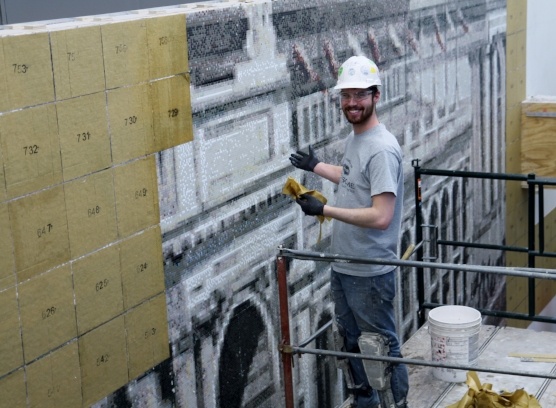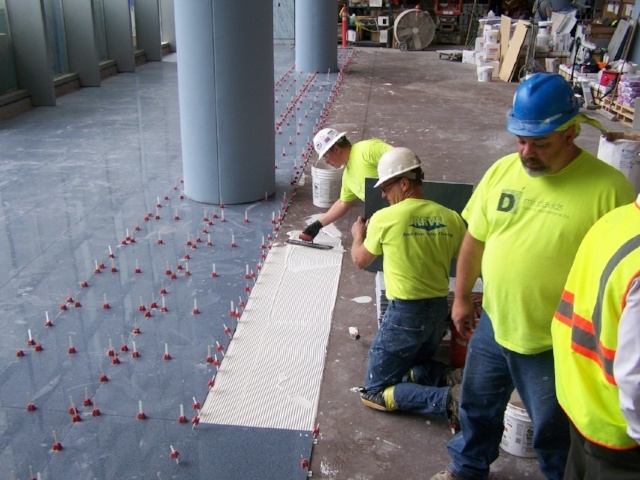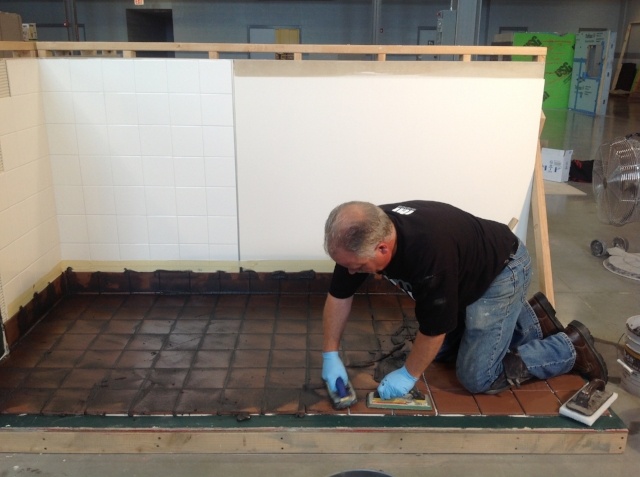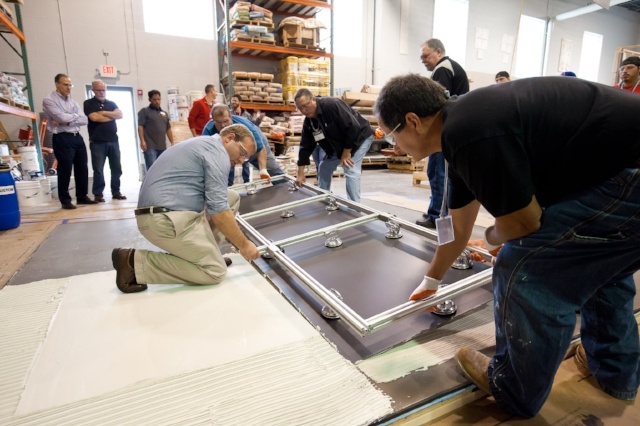
Architectural Innovations
Architects have a long tradition of integrating new construction materials and technologies into their designs, as well as using traditional materials in new and innovative ways. Many materials and systems have evolved and improved in response to the demands of today’s architects. An excellent example is the continuing development of ceramic and porcelain tile materials and systems over the past fifteen years. Manufacturers of tile, setting materials, membranes, grouts, and other system components have generally met these evolving design requirements, and have improved their products in lockstep with them. However, it’s not enough to have great materials and great designs. One additional critical element is needed: installers who are trained and qualified to do the work successfully. This article will look at the evolution of ceramic tile systems and the corresponding story of how installer qualifications have transitioned from barely-acknowledged to the forefront of the industry.
How have tile systems changed?
A decade or two ago, a 12-in. x 12-in. tile was considered large. Tile was set in a sand and cement mud bed so the substrate really didn’t need to be flat; or it was adhered with thinset mortar, and grouted with a basic cementitious grout or possibly epoxy grout. Today, a tile is commonly at least 24-in. long, and sometimes as large as 5 ft. x 10 ft. and as thin as 1/8 in. Concrete and other substrates are rarely flat enough to accept a tile finish without some kind of remedy. Chemical companies have developed membranes that offer waterproof, crack isolation, and acoustic properties, sometimes in the same application. Options for setting materials have expanded with the development of high performing mortars, and new types of high performing grouts have also been developed.
Each of these new innovations have required tile contractors and tile setters and finishers to learn and become skilled in new techniques that were often substantially different than what they were accustomed to. Typically, good contractors with trained, union installers were conscientious about keeping up with these changes; but unfortunately certain segments of the construction community were not, and failures in tile installations became more prevalent. Rightly or wrongly, material manufacturers were held accountable. They reacted by advocating an increased level of quality among tile contractors and installers.
 The tile industry becomes organized
The tile industry becomes organized
In 2012, Tile Council of North America (TCNA), an organization with a large manufacturer membership, and the National Tile Contractors Association (NTCA) reached out to the International Union of Bricklayers and Allied Craftworkers (BAC), the organization representing union tile installers across the United States and Canada; the International Masonry Institute (IMI), the organization responsible for delivering the apprenticeship and training programs for the BAC; the Tile Contractors Association of America (TCAA), the all-union tile contractors’ organization; and other industry associations, with the goal of creating a task force charged with identifying key skill areas that installer should further develop in order to achieve successful installations. This movement would come to be known as the development of installer qualifications, or qualified labor.
By this time, some of the groundwork had already been laid for this new focus on qualified labor. A few years prior, NTCA had established their top-tier contractor certification program known as “Five Star,” and TCAA had also established their own union contractor certification, “Trowel of Excellence.” Each of these contractor certifications require continuing education and training for the contractors, as well as demonstrations of financial stability and good business practices. Trowel of Excellence designation requires completion of IMI’s Contractor College program, ensuring that the union tile contractors are equipped with the latest technical and installation information.
ACT Certifications
The task force on qualified labor acknowledged that the tile industry greatly benefited as a result of these contractor certifications, but to further guard against failures, the industry needed to develop certifications for the tile installers themselves, the employees of the contractors. After much deliberation from all segments in the industry, seven independent skill sets were identified, and it was agreed that the industry develop a set of certifications that would measure the skills of the installers for each of these critical areas. These would come to be known as the Advanced Certifications for Tile Installers, or ACT Certifications. Today, the ACT certifications include the following:
- Large format tile
- Membranes
- Mud floors
- Mud walls
- Shower receptors
- Thin gauged porcelain tiles and tile slabs/panels
- Grouts
 The certifications are available to any installer who meets the requirements, which will be outlined below. The certifications are independent of one another, i.e. an individual may be certified in one or more. They are held by the individual installer, not the contractor. And perhaps most importantly, the purpose of the ACT certifications is to measure and document the skills of the installers, they do not constitute a training program.
The certifications are available to any installer who meets the requirements, which will be outlined below. The certifications are independent of one another, i.e. an individual may be certified in one or more. They are held by the individual installer, not the contractor. And perhaps most importantly, the purpose of the ACT certifications is to measure and document the skills of the installers, they do not constitute a training program.
For an installer to become ACT certified in one of the skill areas listed, first he must be an experienced installer: either a BAC journeyman tile setter or in the case of non-union, certified by the Ceramic Tile Education Foundation (CTEF). Once these criteria are met, the installer is tested on his knowledge of the TCNA Handbook for Ceramic, Glass, and Stone Tile Installation and the ANSI Standards for installation of ceramic tile, ANSI A108. Only if and when the installer achieves a score of 85% or better on the written exam, he qualifies to demonstrate his skills on a hands-on installation module that will be graded by an ACT-certified evaluator. This practical exam takes between 4 and 6 hours depending on the certification, and it is graded consistently against critical points established by the ACT advisory group. If the module is given a passing grade by the evaluator, the installer is awarded his ACT certification for that particular skill. Each certification is good for three years, at which point the installer needs to re-take the written portion of the test, as it is very likely that ANSI standards may have changed.
Tile industry standards acknowledge qualified labor
TCNA has strongly recommended the use of qualified labor in their annual issue of the Handbook since 2012, citing Journeyman Tile Apprentice Programs, Trowel of Excellence certification, and IMI Contractor College as examples of exemplary industry programs. The TCNA Handbook added ACT certifications to this list in 2015, and it has appeared each year since. In 2013, MasterSpec, the master guide specification published by Arcom, introduced sections on Installer Qualifications in Part 1 of all four tile specification sections they publish.
Soon, the ANSI standards will also include qualified labor language. The newly developed ANSI A108.19, Interior Installation of Gauged Porcelain Tiles and Gauged Porcelain Tile Panels/Slabs by the Thin-Bed Method bonded with Modified Dry-Set Cement Mortar or Improved Modified Dry-Set Cement Mortar is expected to make reference to the ACT certification for thin gauged porcelain tile in its section on qualified labor. The importance of qualified labor may best be summed up by this quote in the TCNA Handbook: “Because tile is a permanent finish, the lowest bid should not be the driving factor, but rather who is the most qualified to perform the scope of the work specified.”
 How architects can positively influence quality of construction
How architects can positively influence quality of construction
Qualified labor language in the architectural specifications will undoubtedly benefit the project, the client, and the architect by ensuring that the work is done by a qualified contractor and qualified installers. Listing the qualification data in Tiling specification, PART 1, QUALITY ASSURANCE is a great step in the right direction, but it will only be effective to the extent it is enforced. Specifications should also require submittal of qualification data in PART 1, INFORMATION SUBMITTALS.
Many architects reference ANSI A108 and the TCNA Handbook in their project specifications. These documents are voluntary standards, not codes, but if referenced by the contract documents, they can and should be enforced. ANSI A108.19, when approved, is expected to contain an informative note advising the architect to require compliance of the required installer qualification criteria in the form of an informational submittal, so the installing contractor’s qualifications can be verified.
Conclusion
The most critical and basic step in ensuring quality construction on any tile project is craftworker training. The apprenticeship and training programs of IMI have consistently prepared tile installers for the rigorous demands of the industry with their pre-apprentice, apprenticeship, and related training programs. As materials and technologies have become more advanced, the tile industry has responded with qualification and certification programs that address even the most specialized areas of the trade. With sample Qualified Labor language found in MasterSpec, manufacturers’ literature, the TCNA Handbook, and even ANSI standards, the industry has acknowledged the critical role that tile contractors and installers play in the success of a tile installation. Today, architects have the opportunity to do a great service to their clients by writing qualified labor language into the Tiling specifications, and as partners in the industry, architects, material manufacturers, contractors and installers are working together to provide top quality tile installations.
Note: This article first appeared in Licensed Architect Magazine, Spring 2017.http://www.nxtbook.com/naylor/ALATQ/ALATQ0117/index.php?startid=28



